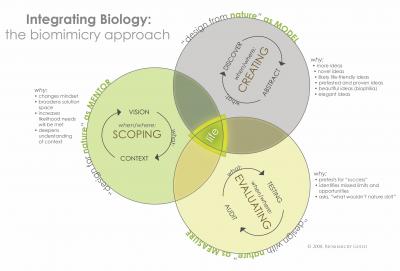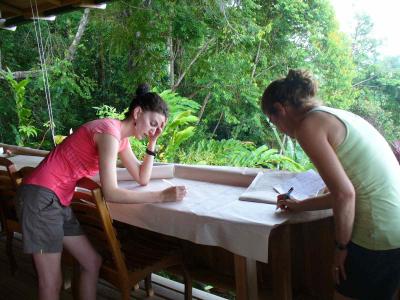Biomimicry and Industrial Design (Karen Verbeek)
 Biomimicry is increasingly becoming part of the regular lexicon of industrial design and sustainability. It is even making its way into mainstream media and popular print. Now Magazine ran "Bring on nature’s design firm" this summer as the cover story. Our local community paper, "The Banner" recently featured the article "Nature’s brilliance offers hope for future" by David Suzuki. Those of us in the biomimicry community are asking "Great! Where are we making progress with biomimicry in business and to what degree are we involved at the product development level?"
Biomimicry is increasingly becoming part of the regular lexicon of industrial design and sustainability. It is even making its way into mainstream media and popular print. Now Magazine ran "Bring on nature’s design firm" this summer as the cover story. Our local community paper, "The Banner" recently featured the article "Nature’s brilliance offers hope for future" by David Suzuki. Those of us in the biomimicry community are asking "Great! Where are we making progress with biomimicry in business and to what degree are we involved at the product development level?"
The business case for sustainability hinges on design. To put a plan into action or give form to an idea or attributes to a concept requires that we consciously design towards those goals. In the past, companies seen as design leaders have harnessed the strength of industrial design to become market leaders and produce iconic designs. Companies such as Braun and Olivetti applied the highest standards of ergonomics, aesthetics and manufacturing processes to a very carefully thought out product line. Today, Apple develops a limited product line of very well designed products with the highest level of attention to these traditional design criteria.
Increasingly, we are adding sustainability to the design brief and industrial designers must translate this requirement into viable solutions. Biomimicry provides a framework and a methodology for the sustainable solution space. The leadership of companies such as PAX Scientific, Interface, WhalePower and REGEN Energy show how biomimicry has influenced product development and placed these companies into a class of their own.
This article is based on an informal survey of industrial designers and other sources to better understand where we are today in implementing biomimetic approaches.
Sustainability and Design
 Design is central to the social, environmental and economic benefits of sustainability in product development. Traditionally, the business case for design was based on criteria such as cost savings, product improvement, ergonomics and user needs. The current driver of sustainability is significantly more complex and multidimensional. How do designers address a greater variety of difficult criteria regarding sustainability issues while balancing cost, manufacturing and consumption issues? Although challenging, incorporating sustainability significantly multiplies the benefits of what industrial design can offer.
Design is central to the social, environmental and economic benefits of sustainability in product development. Traditionally, the business case for design was based on criteria such as cost savings, product improvement, ergonomics and user needs. The current driver of sustainability is significantly more complex and multidimensional. How do designers address a greater variety of difficult criteria regarding sustainability issues while balancing cost, manufacturing and consumption issues? Although challenging, incorporating sustainability significantly multiplies the benefits of what industrial design can offer.
As a key conduit for biomimicry knowledge, design has to capture the attention and imagination of business. What does business want from design that biomimicry can provide? Systems and solutions that are more responsive to a more dynamic environment, inherent smartness and ongoing improvement are expected from product solutions of the 21st century. Interdisciplinary collaboration across traditional silos such as departments, faculties and professions is increasingly required to generate creative and innovative solutions in today's complex world. These benefits are often attributed to the biomimicry design process. Biomimicry offers a useful framework as it focuses on functions and outcomes developed with input from a variety of disciplines.
Participants in this informal survey cited some challenges to successfully implementing the biomimicry process. Two that were most often cited are timing and repeatability. There has not been enough time to reach critical mass through educational avenues or practical applications. Designers, educators and students also mentioned how the biomimetic approach can extend project timelines for a variety of reasons. In addition, repeatability is critical to give designers the confidence that they can develop a robust, implementable solution every time.
Impact of Biomimicry on Design
 Biomimicry serves as a lens that expands the solution space by directing us to the functional solutions already available in nature. It becomes second nature for us to ask questions about the natural strategies and principles. The degree to which strategies can be understood and applied depends on circumstance, communication and opportunity. This presents a broadened role for designers as biomimicry educators and advocates, not unlike the role designers play in advocating for sustainable design by adopting the Designers Accord initiated and championed by Valerie Casey.
Biomimicry serves as a lens that expands the solution space by directing us to the functional solutions already available in nature. It becomes second nature for us to ask questions about the natural strategies and principles. The degree to which strategies can be understood and applied depends on circumstance, communication and opportunity. This presents a broadened role for designers as biomimicry educators and advocates, not unlike the role designers play in advocating for sustainable design by adopting the Designers Accord initiated and championed by Valerie Casey.
We cannot simply add sustainability as yet another design criteria. Sustainability needs to be incorporated into all phases of the design process. If we are to gain the greatest benefit, we will need to revisit our understanding of the root causes of the problems we are trying to solve. Biomimicry can encourage a mind shift to see problems from a new perspective.
Barriers to Practicing Biomimicry
What are the common challenges designers are facing using biomimicry? Biomimicry is complex, multi-dimensional, inter-disciplinary and collaborative. While it is a strong and powerful approach, it is not especially easy to manage. There are relatively few case studies compared to standard engineering and design success stories. While this is true of any new discipline, the numerous environmental challenges we face are forcing us to move fast. Biomimicry offers the advantage of being based on an existing body of time-tested solutions. In addition, it is a bridge between other disciplines, giving it strength, flexibility and wide application as a methodology. By understanding and mimicking what has worked in the natural world, we can use these principles with the current available technology to moving biomimicry forward in the most productive manner.
- the shift in the design approach – integrating the biological discovery phase into design
- managing the changing role and opportunities of design
- role of the designer as educator and advocate
- strong and varied examples
- the learning curve and time for the discipline to be adopted
- translating the principles (abstraction to the design concept)
Designers' Aspirations for Biomimicry
 What about the changing role of products in the product ecosystem? How does this relate to natural systems? The functional adaptations of organisms are a specific reaction to stresses in their environments. In many ways, this describes what a product is. Ecosystems provide everything for that organism to flourish. As the nature of the very products we design changes, the relationship to the product ecosystem becomes increasingly important. For example, many of our products are now incorporating wireless communication. These products have a complex relationship with numerous other products: the boundaries are porous and not necessarily distinct. It emphasizes how different the material, form-giving aspects of industrial design have become compared to just a relatively short time ago. These products may have physical boundaries but their function does not end there.
What about the changing role of products in the product ecosystem? How does this relate to natural systems? The functional adaptations of organisms are a specific reaction to stresses in their environments. In many ways, this describes what a product is. Ecosystems provide everything for that organism to flourish. As the nature of the very products we design changes, the relationship to the product ecosystem becomes increasingly important. For example, many of our products are now incorporating wireless communication. These products have a complex relationship with numerous other products: the boundaries are porous and not necessarily distinct. It emphasizes how different the material, form-giving aspects of industrial design have become compared to just a relatively short time ago. These products may have physical boundaries but their function does not end there.
The role of the designer in the product development team is expanded when biomimicry informs the process and leads to new product opportunities. The designer becomes the facilitator to move between different disciplines, looking through the functional biological lens to clarify the problem statement and to generate concepts. The classic definition of an industrial designer has always been more or less like this definition from Carleton University: "A physical solution that optimizes the function, value and appearance of a product or system for the benefit of the user. It includes features such as shape, configuration, pattern and ornamentation or any combination of these features." Or from the Industrial Design Society of America (IDSA): "Industrial design (ID) is the professional service of creating and developing concepts and specifications that optimize the function, value and appearance of products and systems for the mutual benefit of both user and manufacturer." Sustainability is integral to the design process and biomimicry fits right into the definition of industrial design, especially if we expand the scope of words like function, value, user, systems and of course, manufacturer!
Design has always been a collaborative, facilitative process that brings about solutions based on asking the right questions. Using biomimicry as a framework allows these questions to be framed in a sustainable context. The solutions are based on a much wider solution space yet are based on a much more focused functional subset. Biomimicry is so much more complex and complete in how it addresses systems issues, resilience, symbiotic relationships and benign materials: the very issues we have been highly unsuccessful in dealing with to date. Have we been so enamored with our own cleverness at making new things that we might have missed the existing solutions right under our own noses? Our entire manufacturing and world-wide economy is petroleum-based and relies on resource-extracting manufacturing processes. This has prevented us from exploring natural water-based, low-temperature processes that are at the heart of biomimicry, and that are the focus of green chemistry. Life is supported by dynamic non-equilibrium as an operating condition. Managing dynamic non-equilibrium to provide the continuous change and control for our human needs will take creativity, insight and co-operation. This is a completely different paradigm and a new exciting landscape.
Those who have taken biomimicry courses say that it forever changes how they see problems and solutions. Life’s principles become constant guidelines. What would nature do? How would nature solve this? There is no going back.
Suggested Readings
- Klein, A. (2010, August 19-26). Bring on nature’s design firm. Now Magazine, 29(51)
- Suzuki, D., with Moola, F. (2010, October 31). Nature’s brilliance offers hope for future. The Era Banner, 6
- Casey, V. The Designers Accord
- Gulmanelli, S. (2008, February). BioMimicry. DOMUS, suppl.Green, 32-37
- Pulfer, R. (2008, May). Form follows Nature. Azure
Image Credits:
- Segmented ball: © Yang MingQi - Fotolia.com
- Integrating Biology: The Biomimicry Guild (check The Biomimicry Institute website for the latest version)
- Industrial Ecology: Carla Gould
- Biomimicry Costa Rica Workshop (2009): Karen Verbeek

Karen Verbeek has a biology and industrial design background and attended the Costa Rica Biomimicry Workshop. She is currently focusing on education in the Greater Toronto Area and building a biomimicry network.

Comments
Biomimicry and designers
Thanks for this interesting article!
What you said about repeatability is very true, I think, not only for designers to be convinced about biomimicry but also their clients. Biomimicry can mean that some drastic changes has to be made, and especially companies / clients want to be sure it can be done and that is makes a positive difference.
I was wondering how you see designers becoming biomimicry educators and advocates. As a designer I really would like to take that role but than again I know that designers often have to deal with their project leaders / bosses / clients to whom they have to listen, and not always having the possibility and the space to add their own opinions and visions within the project. Do you have any ideas on how this "weaker" position can be combined with an educator and advocate role for designers?
Designers becoming biomimicry educators and advocates
Mike, you raise an excellent question: what approach should designers take in introducing biomimicry into their organisations. In a perfect world, you would be able to win over a key decision maker who then directs the organisation to adopt the principles of biomimicry. Unfortunately, most businesses are run by people who are driven by meeting budgets and deadlines. Even in the ideal case, biomimicry needs to show results if it is to gain momentum within the organisation.
I think it is essential to figure out how biomimicry might solve specific problems with the organisation. What challenges is the organisation facing in terms of supporting their current customers and growing the business? What information, tools/methods and resources are available to help turn biomimetic concepts into reality? What type of emulation (form, function, system) is the best fit? Should the focus be on specific biomimetic examples or higher level concepts such as the Life's Principles? I am not suggested that biomimicry is limited in its scope, but believe it is essential to qualify opportunities given the specific situation and the availability of resources. It is easy to get caught up in the idea, raising expectations that later prove to be hard to satisfy.
Your comment also alludes to the role of the designer within the end-to-end design process. I believe biomimicry works best in an environment where designers are involved early and often. The opportunities to make substantial contributions are limited if the influence of designers is restricted to specific stages of the end-to-end design process. The waterfall design process is increasingly being replaced by concurrent engineering and Integrated Design Processes. Biomimicry can help in this transition, especially if it can deliver consistent results.
Reply to come
I replied to this earlier but had technical difficulties when I switched windows and lost my message! Anyway, in the meantime, it has been a busy few weeks, but I will get back to you with some comments as a response. I have a few ideas to share with you...